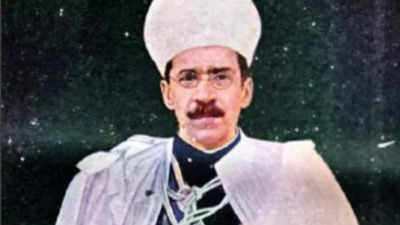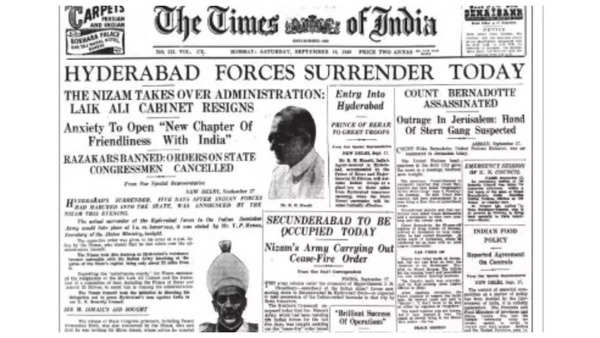- News
- The Times of a Better India News
- Why every political party will seek to resurrect Nizam in Hyderabad today
This story is from September 17, 2022
Why every political party will seek to resurrect Nizam in Hyderabad today

Mir Osman Ali Khan, Nizam VII, the last ruler of Hyderabad
On the 75th anniversary of Hyderabad’s annexation to the Indian Union, opinion is sharply divided over whether it was ‘liberation’ of the state, or ‘integration’, and if the Nizam was a ‘cruel, feudal ruler’
In 1922, Mir Osman Ali Khan, the Nizam VII of the princely state of Hyderabad, issued a firman (government order) banning the slaughter of cows in his dominion.The Akhil Bharatiya Hin du Mahasabha, headed by Pandit Madan Mohan Malaviya at its Gaya session later that year passed a resolution praising and thanking the Nizam for the gesture.
A decade earlier, soon after assuming charge as the Nizam, Osman Ali Khan virtually abolished capital punishment by keeping with himself the power to review a death sentence. In his 37-year reign he commuted every death sentence to a life term except one, where a junior army officer had killed his senior. These judicial reforms have been documented in the Law Commission’s 35th report.
A century later, the Nizam has now become the rallying point for electoral politics in Telangana, one of the three regions of the erstwhile Hyderabad dominion. Though the Nizam is resurrected before every election in the state, this is the first time that all political parties have planned mega rallies on September 17, marking the 75th anniversary of the annexation of Hyderabad state into the Indian Un ion. Incidentally, the AIMIM, which is often accused of being the political vestige of the violent Razakar movement, has now declared the Nizam a “feudal ruler”.
But outside of political circles, city historians and members of the Nizam’s family argue that ther e’s nothing to celebrate about September 17, 1948, when the Indian government carried out Operation Polo, popularly known as Police Action, to annex the princely state. For, the events that preceded and followed Operation Polo were marred by bloodshed, death and destruction. Some 40,000 died, and lakhs were dislocated.
Ironically, while those in support of “liberation” day limit themselves to highlighting the violence and mayhem that preceded the Police Action, those in favour of “integration” day tend to focus on the killings that succeeded the merger.
If the Razakars (volunteers) led by Khasim Rizvi and backed by local landlords, both Hindu and Muslim, ran a parallel government unleashing a reign of terror and bringing pressure on the Nizam to declare
an “independent” Hyderabad before the Police Action, the army was accused of remaining a mute spectator as armed men went on the rampage targeting a section of people. Then Prime Minister Pandit Jawaharlal Nehru set up a committee headedby Pandit Sundarlal to inquire and report on the post-Police Action violence. The committee estimated that between 24,000 and 40,000 people of a comm unity were killed. With the electoral politics now revolving around the Nizam and his rule, the descendants of the last ruler of princely Hyderabad have come out in the open in defence of their forefather. “The Nizam would state that ‘Hindus and Muslims are like my two eyes, how can I favour one eye over the other’?” recalls his grandson Najaf Ali Khan. Khan claims the Nizam was held under duress by Khasim Rizvi and prime minister Laiq Ali, who dethroned the Nawab of Chhattari in an overnight bloodless coup in 1947 to occupy the position, and the decisions “taken” by the Nizam that led to the Police Action were in fact those of Rizvi and Laiq Ali.

Except for the Razakar backlash at the fag end of his regime, the Niz am took decisions that were considered revolutionary in those days. Before India became independent, he had effected a separation of the judiciary from the executive. He subjected himself to judicial review, hardly the hallmark of a feudal ruler. The journalist Theo La Touche wrote about these re-Join the Times Special Readers’ Club. Scan the QR code toforms in his book, ‘India’s Premier Ruling Prince’, published in 1944.
Archival records show that before banning cow slaughter in 1922, the Nizam had banned sacrifice of cows on Bakr-id. He supported a public security committee formed after the first-ever communal distur bance in Hyderabad in 1938. Hyderabad was a leading industrial state with as many as 659 industries way back in 1944. Himayat Ali Mirza, the great grandson of Nizam VII, regrets that “though his great grandfather had banned cow slaughter, restored Ajanta and Ellora paintings and gave annual donations to several temples, he is targeted in the ce ntennial year of ban on killing of cows. These politicians don’t know the true history of Hyderabad,” he says.
In 1922, Mir Osman Ali Khan, the Nizam VII of the princely state of Hyderabad, issued a firman (government order) banning the slaughter of cows in his dominion.The Akhil Bharatiya Hin du Mahasabha, headed by Pandit Madan Mohan Malaviya at its Gaya session later that year passed a resolution praising and thanking the Nizam for the gesture.
A decade earlier, soon after assuming charge as the Nizam, Osman Ali Khan virtually abolished capital punishment by keeping with himself the power to review a death sentence. In his 37-year reign he commuted every death sentence to a life term except one, where a junior army officer had killed his senior. These judicial reforms have been documented in the Law Commission’s 35th report.
A century later, the Nizam has now become the rallying point for electoral politics in Telangana, one of the three regions of the erstwhile Hyderabad dominion. Though the Nizam is resurrected before every election in the state, this is the first time that all political parties have planned mega rallies on September 17, marking the 75th anniversary of the annexation of Hyderabad state into the Indian Un ion. Incidentally, the AIMIM, which is often accused of being the political vestige of the violent Razakar movement, has now declared the Nizam a “feudal ruler”.
The Union ministry of culture, he aded by G Kishan Reddy, who represents the Secunderabad Lok Sabha constituency, has decided to celebrate the “liberation” of Hyderabad for a year. The Telangana Rashtra Samiti (TRS), the Congress and the AIMIM are, for the first time, openly joining the celebrations with Tiranga rallies. They will, of course, celebrate the “integration” — and not “liberation” — of Hyderabad. However, the BJP, which has set its eyes on winning Telangana in next year’s assembly polls, is harping on “liberation”.
But outside of political circles, city historians and members of the Nizam’s family argue that ther e’s nothing to celebrate about September 17, 1948, when the Indian government carried out Operation Polo, popularly known as Police Action, to annex the princely state. For, the events that preceded and followed Operation Polo were marred by bloodshed, death and destruction. Some 40,000 died, and lakhs were dislocated.
Ironically, while those in support of “liberation” day limit themselves to highlighting the violence and mayhem that preceded the Police Action, those in favour of “integration” day tend to focus on the killings that succeeded the merger.
If the Razakars (volunteers) led by Khasim Rizvi and backed by local landlords, both Hindu and Muslim, ran a parallel government unleashing a reign of terror and bringing pressure on the Nizam to declare
an “independent” Hyderabad before the Police Action, the army was accused of remaining a mute spectator as armed men went on the rampage targeting a section of people. Then Prime Minister Pandit Jawaharlal Nehru set up a committee headedby Pandit Sundarlal to inquire and report on the post-Police Action violence. The committee estimated that between 24,000 and 40,000 people of a comm unity were killed. With the electoral politics now revolving around the Nizam and his rule, the descendants of the last ruler of princely Hyderabad have come out in the open in defence of their forefather. “The Nizam would state that ‘Hindus and Muslims are like my two eyes, how can I favour one eye over the other’?” recalls his grandson Najaf Ali Khan. Khan claims the Nizam was held under duress by Khasim Rizvi and prime minister Laiq Ali, who dethroned the Nawab of Chhattari in an overnight bloodless coup in 1947 to occupy the position, and the decisions “taken” by the Nizam that led to the Police Action were in fact those of Rizvi and Laiq Ali.

The coverage of the police action leading to Hyderabad’s annexation in The Times Of India edition of September 18, 1948.
Except for the Razakar backlash at the fag end of his regime, the Niz am took decisions that were considered revolutionary in those days. Before India became independent, he had effected a separation of the judiciary from the executive. He subjected himself to judicial review, hardly the hallmark of a feudal ruler. The journalist Theo La Touche wrote about these re-Join the Times Special Readers’ Club. Scan the QR code toforms in his book, ‘India’s Premier Ruling Prince’, published in 1944.
Archival records show that before banning cow slaughter in 1922, the Nizam had banned sacrifice of cows on Bakr-id. He supported a public security committee formed after the first-ever communal distur bance in Hyderabad in 1938. Hyderabad was a leading industrial state with as many as 659 industries way back in 1944. Himayat Ali Mirza, the great grandson of Nizam VII, regrets that “though his great grandfather had banned cow slaughter, restored Ajanta and Ellora paintings and gave annual donations to several temples, he is targeted in the ce ntennial year of ban on killing of cows. These politicians don’t know the true history of Hyderabad,” he says.

About the Author
Syed AkbarSyed Akbar is a senior journalist from Hyderabad. He is a specialist-journalist in science, technology, health, politics, environment, development, wildlife, religion, communities, and consumer affairs. He has been in the profession for the last 24 years. Before joining The Times of India, he worked with Deccan Chronicle and Indian Express.
FOLLOW US ON SOCIAL MEDIA